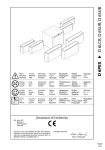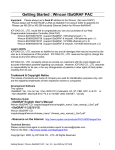Download OMX-4001, 4002,4003,4004 VGA / XGA Distribution
Transcript
OMX-4001, 4002,4003,4004 VGA / XGA Distribution Amplifiers INTRODUCTION Congratulations on your purchase of this OCEAN MATRIX amplifier. This manual includes configuration, operation and information for the following products from the OCEAN MATRIX line of distribution amplifiers. These amplifiers are similar in operation and features. ! ! ! ! OMX-4001 - 1:3 VGA Distribution Amplifier OMX-4004 - 1:4 VGA Distribution Amplifier OMX-4002 - 1:6 VGA/XGA Distribution Amplifier OMX-4003 - 1:12 VGA/XGA Distribution Amplifier A Word on VGA/XGA Distribution Amplifiers VGA/XGA distribution amplifiers distribute one or more signals to several receivers. They vary in the number of inputs, looping capability, programming capability, number of outputs, operating format, bandwidth and input/output coupling. VGA/XGA distribution amplifiers are used to distribute one source to several acceptors (wide screen projectors, format converters, etc.) for simultaneous recording or monitoring of one source, with no discernible signal degradation. The machines excel in very large bandwidth (some approaching 400 MHz) and very good linearity, making them usable for even the highest graphics standards. A good quality distribution amplifier amplifies the incoming signal, may pre-compensate the signal for potential losses (resulting from the use of long cables, noisy source, etc.) and generates several identical buffered and amplified outputs. The front panels of these OCEAN MATRIX amplifiers are designed to be simple to operate. Typical applications of the machines are: computer graphics distribution in classes, point of sale and multimedia studios, and displaying computer graphics before large audiences using the data input of a wide screen video projector. Handling Graphics signals A computer generated graphics signal is usually comprised of 5 signals: Red, Green, Blue - which are analog level signals - and two TTL (logic) level signals Horizontal Sync and Vertical Sync. (Digital graphics cards and monitors use a different signal format, and will not be discussed here, as they are not relevant to this DA.). Computer graphics resolution is measured in pixels and signal bandwidth. The more pixels (picture elements) on the screen, the more detailed is the image. VGA, S-VGA, XGA, S-XGA and U-XGA are terms describing the graphics resolution and the color depth. Color depth represents the maximum number of simultaneously displayed colors on the screen and is measured in bits. 24 and 3236 bits of color depth represent millions to billions of color shades available on the screen at any given moment. It should be born in mind, though; that the human eye can resolve only a few thousands colors! The more the image is detailed (higher resolution) and the higher the color depth, the more real the image will look. Standard VGA highest resolution was 640x480 pixels with 4 bits of color (16 colors). Standard VGA was able to use more colors (256) but at a lower resolutionaround 320x200 pixels - which was very crude. Common resolutions used today for computer graphics vary between 1024x768 and 2000x1600 pixels with “high color” - 16 bits of color (representing 64,000 different colors) up to “true color” 24 bits or more (representing from 16.7 million colors up to several billion.) Displaying such a detailed and colorful image on the screen needs enormous graphics memory per frame, as well as very high speeds for “writing” so many pixels on the screen in real time. Amplifiers that carry such signals must be able to handle those speeds and signal bandwidths. Standard VGA, at 640x480 resolution, needed amplifiers with 20-30MHz bandwidth. At 1600x1200 or even at 1280x1024 (S-XGA), such amplifiers will fail completely. In order to faithfully amplify and transmit modern high-resolution graphics, amplifiers with bandwidths of 300 MHz and more are needed. Those amplifiers, besides the enormous bandwidth they handle, need to be linear, to have very low distortion and be stable. Stability of an amplifier is its ability to avoid bursting into uncontrolled oscillation, which is in adverse relationship to the speed it can handle. The tendency to oscillate is further enhanced by the load impedance. The load impedance of a system is usually not just a resistor. A cable connected to an amplifier (leading to the receiver or monitor) may present a capacitive and/or inductive load to the amplifier. This is the main cause of instability. The poor performance of a load or cable may severely degrade the performance of the amplifier - it’s bandwidth, linearity, and stability and in general its ability to faithfully reproduce the signal. Cables affect image resolution. Longer cables can cause high frequency deterioration and hence image “smear” and loss of resolution. In computer graphics especially, this adverse effect is very much accentuated. Amplifiers should thus also cope with an additional task - compensating for cable losses up to the maximum useful operation distance. High-resolution graphics systems must use very high quality cables for image transmission. The cables should be shielded - to eliminate externally induced interference though the shield might increase the capacitance of the cable and, therefore, cause deterioration in the image’s resolution and clarity. Standard cables can only be a few meters long. For longer distances, compound cable is separated into five individual coax cables, which are bulky and cumbersome for use. Even so, the distance is limited to several tens of meters. Cables may create other problems if they fail to accurately match the system’s required impedance. The result of this, especially at high frequencies, is “shadows” or “ghosts” on the image, resulting from standing waves and electronic reflections running back and forth between transmitter and receiver. Another aspect to consider is the sync. As those signals are logic signals, which are not treated as analog signals, the receiver does not terminate the line, and therefore the line is not matched. A host of problems might occur when signals are sent over long, unterminated, unmatched cables. The result might be image breakdown or distortion due to improper sync information. The amplifier that drives the analog section of the graphics data should also be able to buffer, recover and send the sync information in such a way that it will be received properly at the receiver end. Factors Affecting Quality of Results There are many factors affecting the quality of results when signals are transmitted from a source to an acceptor: ! Connection cables - Low quality cables are susceptible to interference; they degrade signal quality due to poor matching and cause elevated noise levels. They should therefore be of the best quality. ! Sockets and connectors of the sources and acceptors - So often ignored, they should be of highest quality, since "Zero Ohm" connection resistance is the objective. Sockets and connectors also must match the required impedance (75ohm in video). Cheap, low quality connectors tend to rust, thus causing breaks in the signal path. ! Amplifying circuitry - Must have quality performance when the desired end result is high linearity, low distortion and low noise operation. ! Distance between sources and acceptors - Plays a major role in the final result. For long distances between sources and acceptors, special measures should be taken in order to avoid cable losses. These include using higher quality cables or adding line amplifiers. ! Interference from neighboring electrical appliances - These can have an adverse effect on signal quality. Balanced audio lines are less prone to interference, but unbalanced audio should be installed far from any mains power cables, electric motors, transmitters, etc. even when the cables are shielded. How Do I Get Started? The fastest way to get started is to take your time and do everything right the first time. Taking 15 minutes to read the manual may save you a few hours later. You don’t even have to read the whole manual. If a section doesn’t apply to you, you don’t have to spend your time reading it. Unpacking and Contents The items contained in your OCEAN MATRIX distribution amplifier package are listed below. Please save the original box and packaging materials for possible future transportation and shipment of the amplifier. ! ! ! ! ! Amplifier AC power cable (OMX-4001, OMX-4002, OMX-4003 only) 12 VDC wall transformer (OMX-4004) User Manual 4 rubber feet VGA/XGA Distribution Amplifiers This section describes all the controls and connections of your machine. Understanding the controls and connections helps you realize the full power of your machine. Getting to Know Your OMX-4001 Amplifier The OCEAN MATRIX OMX-4001 is a full bandwidth, 1:3 VGA/XGA distribution amplifier designed for computer and workstation applications. The OMX-4001 splits a VGA/Super-VGA/XGA graphics card output to 3 monitors, with no discernible signal degradation. Input and output are DC coupled and conform to the highest standards. Signal bandwidth of 350MHz allows the OMX4001 to be used with the highest quality graphics workstations. INSTALLATION Rack Mounting The OMX-4002 and OMX-4003 amplifiers may be rackmounted in a standard 19” (1U) EIA rack, and have rack “ears” at the ends of the front panel. To mount them, simply place the unit's ears against the rack rails of your rack, and insert standard screws through each of the four corner holes. The OMX-4001 and OMX-4004 models can be table mounted using the rubber feet, or rack mounted using a special adapter. These devices do not require any specific spacing for ventilation above or below the unit. Getting to Know Your OMX-4004 Amplifier The OCEAN MATRIX OMX-4004 is a full bandwidth, 1:4 VGA/XGA distribution amplifier designed for computer and workstation applications. The OMX-4004 splits a VGA/Super-VGA/XGA graphics card output to 4 monitors. The OMX-4004 is DC fed making it suitable for fieldwork. Both the input and the output are AC coupled conforming to the highest standards. Signal bandwidth of 350MHz allows the OMX-4004 to be used with the highest quality graphics workstations. Connecting TO VGA/XGA Devices Video sources and output devices (such as monitors, projectors or recorders) may be connected to the amplifiers through the HD15F type connectors located on the back of the unit. Unused inputs are terminated to 75ohm, and active inputs should be terminated by the connecting source. The signals supported by the various models are Analog Red, Green, Blue signals. Getting to Know Your OMX-4002 Amplifier The OCEAN MATRIX OMX-4002 is a full bandwidth, 1:6 VGA/XGA distribution amplifier designed for computer and workstation applications. The OMX-4002 splits a VGA/Super-VGA/XGA graphics card output to 6 monitors, with no discernible signal degradation. Input and output are DC coupled and conform to the highest standards. Signal bandwidth of 400MHz allows the OMX4002 to be used with the highest quality graphics workstations. USING THE AMPLIFIERS Powering on the Amplifier NOTES Getting to Know Your OMX-4003 Amplifier The OCEAN MATRIX OMX-4003 is a full bandwidth, 1:12 VGA/XGA distribution amplifier designed for computer and workstation applications. The OMX-4003 splits a VGA/Super-VGA/XGA graphics card output to 12 monitors, with no discernible signal degradation. Input and output are DC coupled and conform to the highest standards. Signal bandwidth of 300MHz allows the OMX4003 to be used with the highest quality graphics workstations. 1) 2) ! ! The amplifier should only be powered on after all connections are completed, and all source devices have been powered on. Do not attempt to connect or disconnect any video, audio or control signals to the amplifier while it is powered on! The socket-outlet should be near the equipment and should be easily accessible. To fully disconnect equipment, remove power cord from socket. Press the toggle switch on the far-left front panel to the up position. The toggle switch glows. Operate the acceptors. Technical Specifications: OMX-4001 OMX-4004 OMX-4002 OMX-4003 1:3 DA Analog R, G, B 0.7 Vpp/75 ohms, H, V syncs TTL level on HD 15F connector 3 VGA R, G, B 0.7 Vpp/75 ohms, H, V syncs TTL level on HD 15F connector DC 1:4 DA Analog R, G, B 0.7 Vpp/75 ohms, H, V syncs TTL level on HD 15F connector 4 VGA R, G, B 0.7 Vpp/75 ohms, H, V syncs TTL level on HD 15F connector AC 1:6 DA Analog R, G, B 0.7 Vpp/75 ohms, H, V syncs TTL level on HD 15F connector 1:12 DA Analog R, G, B 0.7 Vpp/75 ohms, H, V syncs TTL level on HD 15F connector 6 VGA R, G, B 0.7 Vpp/75 ohms, H, V syncs TTL level on HD 15F connector 12 VGA R, G, B 0.7 Vpp/75 ohms, H, V syncs TTL level on HD 15F connector DC DC Bandwidth >350MHz, 3dB >350MHz, -3dB 400MHz, -3dB >300MHz, -3dB Diff. Gain 0.17% 0.5% 0.25% 0.09% 0.06 Deg. <0.05% <0.05% 74dB 0.1 Deg. <0.05% <0.05% 73dB 0.05 Deg. <0.05% <0.1% 75.8dB 0.17 Deg. < 0.05% < 0.1% 71dB 24.5x18x4.5 (cm) 9.6" x 7" x 1.8" 24.5x18x4.5 (cm) 9.6" x 7" x 1.8" 48.3x17.8x1U (cm) 19" x 7" x 1U 48.3x17.8x1U (cm) 19" x 7" x 1U 1.4kg. (3.1lbs.) Approx. Power Source 115VAC, 50/60 Hz, 4.3VA 1.1kg. (2.4lbs.) Approx. 12VDC, 75mA 2.4kg (5.2lbs.) Approx. 2.7kg. (6lbs.) Approx. 115VAC, 50/60 Hz 9.2VA 115VAC, 50/60 Hz 15VA Function Inputs Outputs Coupling Diff. Phase K-Factor Non Linearity S/N Ratio Dimensions (W, D, H) Weight OMX-4001, 4002,4003,4004





















